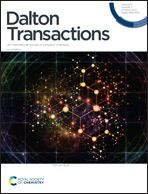Oxygenolysis of a series of copper(ii)-flavonolate adducts varying the electronic factors on supporting ligands as a mimic of quercetin 2,4-dioxygenase-like activity†
Abstract
Four copper(II)-flavonolate compounds of type [Cu(LR)(fla)] {where LR = 2-(p-R-benzyl(dipyridin-2-ylmethyl)amino)acetate; R = –OMe (1), –H (2), –Cl (3) and –NO2 (4)} have been developed as a structural and functional enzyme–substrate (ES) model of the Cu2+-containing quercetin 2,4-dioxygenase enzyme. The ES model complexes 1–4 are synthesized by reacting 3-hydroxyflavone in the presence of a base with the respective acetate-bound copper(II) complexes, [Cu(LR)(OAc)]. In the presence of dioxygen the ES model complexes undergo enzyme-type oxygenolysis of flavonolate (dioxygenase type bond cleavage reaction) at 80 °C in DMF. The reactivity shows a substituent group dependent order as –OMe (1) > –H (2) > –Cl (3) > −NO2 (4). Experimental and theoretical studies suggest a single-electron transfer (SET) from flavonolate to dioxygen, rather than valence tautomerism {[CuII(fla−)] ↔ [CuI(fla˙)]}, to generate the reactive flavonoxy radical (fla˙) that reacts further with the superoxide radical to bring about the oxygenative ring opening reaction. The SET pathway has been further verified by studying the dioxygenation reaction with a redox-inactive Zn2+ complex, [Zn(LOMe)(fla)] (5).



 Please wait while we load your content...
Please wait while we load your content...